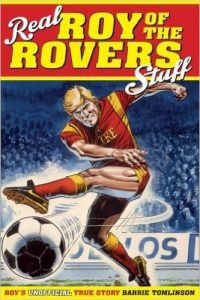Book Review: Real Roy of the Rovers Stuff – Roy’s Unofficial True Story by Barrie Tomlinson
 For men of a certain age Roy of the Rovers is a reminder of their childhood and of days eagerly waiting to get their hands on the weekly edition of the comic, featuring the adventures of the fictional footballer, Roy Race.
For men of a certain age Roy of the Rovers is a reminder of their childhood and of days eagerly waiting to get their hands on the weekly edition of the comic, featuring the adventures of the fictional footballer, Roy Race.
Roy first appeared in the Tiger in 1954, before a new distinct comic was launched in 1976 titled Roy of the Rovers, in which the Melchester Rovers striker was the feature story. It ran until March 1993, before being relaunched as a monthly publication in September 1993, finally closing in March 1995.
The author of Real Roy of the Rovers Stuff – Roy’s Unofficial True Story, Barrie Tomlinson, was inextricably linked with the character for over 25 years. This was initially as a sub-editor and later as editor of Tiger, and indeed Tomlinson was responsible for launching Roy of the Rovers as a separate title in 1976.
Given this longstanding association Tomlinson is ideally placed to tell the story of a character that has become so ingrained in our sporting psyche, that the term, Roy of the Rovers, has become embedded in sporting circles, relating to acts of sporting heroics from seemingly impossible situations.
The book is dominated by chapters that look at the highs and lows of the fictional career of Roy Race and the real-life story of Tomlinson’s involvement in producing and promoting one of the most well-known comic characters.
What is interesting to consider is that during the time of the comics popularity, was that many high-profile sports stars and entertainers were happy to be associated with the character. It is inconceivable today that any publication would have the same unfettered access that Tomlinson was able to create.
Tomlinson’s care for Roy Race, borne out of the years involved with the character, shines constantly through the pages. However, there is also a sense of frustration and nostalgia that is evident when Tomlinson talks of the period when he was no longer responsible for the character. This break is dealt with all too briefly under the heading, All Change at Roy of the Rovers!
Indeed, to give only a page and a half to the change in direction is something that could leave potential readers of the book frustrated. The reasons wouldn’t have needed to be detailed in a voyeuristic or titillating account of, ‘who said this and who said that’, but rather the plain facts about what happened and the rationale for the decisions that were made.
As a result Tomlinson’s book only deals with his time with Roy, and not the storylines that appeared after 1990, reflecting, “It’s just best to go back to the golden era of Roy of the Rovers…when he was my best friend and I was his editorial boss.” It is in itself a very telling comment on the direction of the plots that the later years of the Melchester Rovers hero took.
Given Tomlinson’s vast experience in the trade, it would have been good to see within this book his views on the reasons for the demise of comics such as Tiger, Scorcher and Roy of the Rovers and whether they have any future in the current digital age.
Does this book prove to be a winner for Roy? On this occasion not quite and he’ll have to settle for score draw.
 …. the thing about Roy Race is, well, he’s not really real but he’s sort of real in a life-mirrors-cartoon kind of way. Roy started out looking like Burnley’s Ray Pointer, big blond quiff and all but, as fashions changed, so did Roy’s haircut. To be seen as ‘with it’, suddenly, his hair was combed forward in a way that eerily anticipated Kenny Dalglish’s quizzical look. All the things that were deemed to be happening in the football world from the fifties through to the nineties, Roy and his team, the mighty Melchester Rovers did. European Cups, being kidnapped, repeatedly – all the exciting things that were being covered by the newspapers were given a slight fictional twist and fed to the boys who avidly read their weekly Tiger then Roy of the Rovers comics.
…. the thing about Roy Race is, well, he’s not really real but he’s sort of real in a life-mirrors-cartoon kind of way. Roy started out looking like Burnley’s Ray Pointer, big blond quiff and all but, as fashions changed, so did Roy’s haircut. To be seen as ‘with it’, suddenly, his hair was combed forward in a way that eerily anticipated Kenny Dalglish’s quizzical look. All the things that were deemed to be happening in the football world from the fifties through to the nineties, Roy and his team, the mighty Melchester Rovers did. European Cups, being kidnapped, repeatedly – all the exciting things that were being covered by the newspapers were given a slight fictional twist and fed to the boys who avidly read their weekly Tiger then Roy of the Rovers comics.